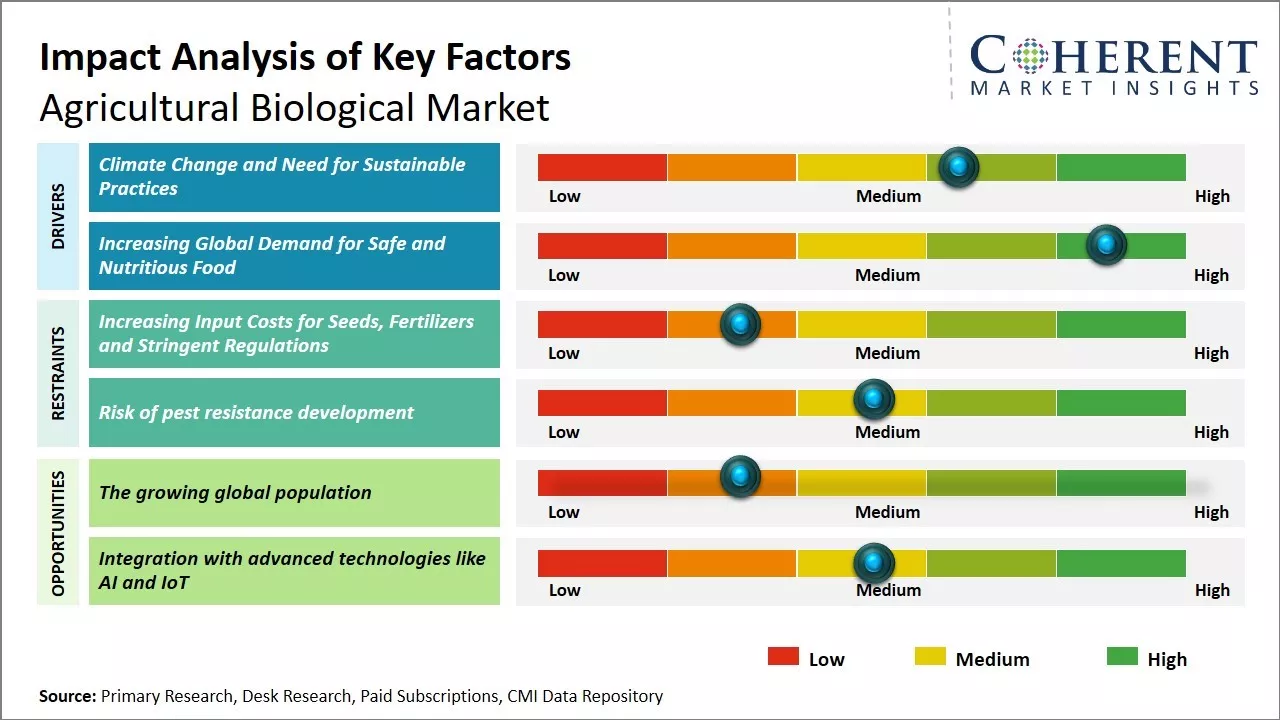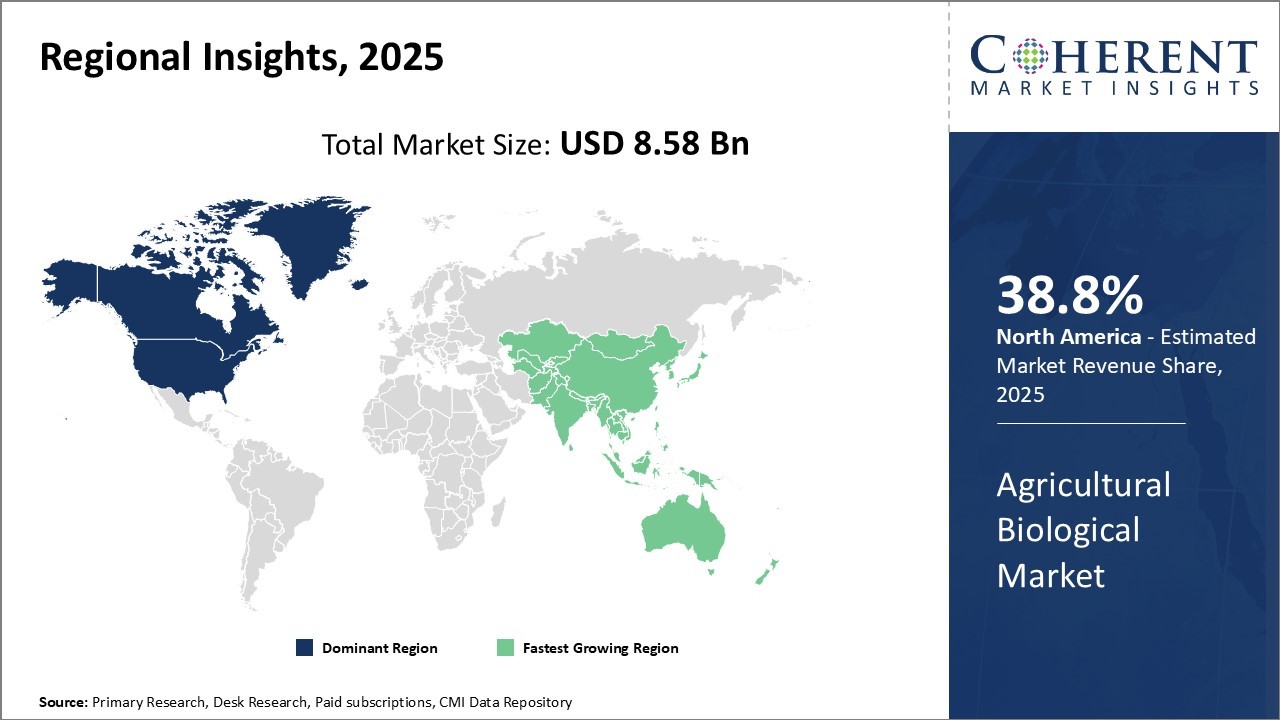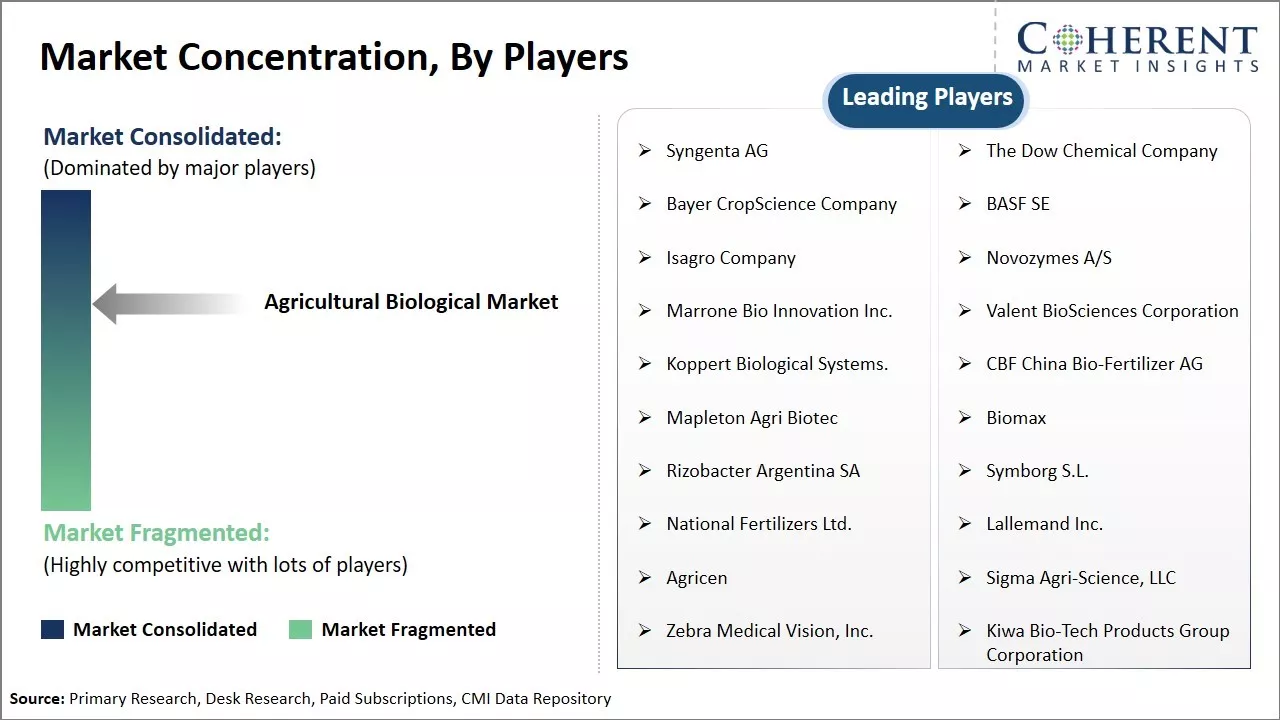Global agricultural biologicals market is estimated to be valued at USD 8.58 Bn in 2025 and is expected to reach USD 16.41 Bn by 2032, exhibiting a compound annual growth rate (CAGR) of 9.7% from 2025 to 2032.

To learn more about this report, Download Free Sample
The agricultural biological market involves the development and use of biological products such as biopesticides, biostimulants and biofertilizers as substitutes for traditional agricultural chemicals to improve crop productivity and soil health in a sustainable manner. The global agricultural biological market demand is expected to witness significant growth over the forecast period due to growing awareness among farmers about the environmental and health hazards caused by excessive use of agrochemicals. Strict government regulations pertaining to the use of chemical pesticides and fertilizers are further encouraging farmers to adopt biological alternatives. Declining soil fertility and increasing organic farmland is further boosting the demand for agricultural biological products worldwide.
|
Current Event |
Description and its Impact |
|
Regulatory Shifts Driving Alternative Adoption |
|
|
Investment and Market Expansion Trends |
|
Uncover macros and micros vetted on 75+ parameters: Get instant access to report
India ranks among the world's top exporters of agricultural products. During the first nine months of FY25 (April to December), the total value of agricultural exports reached ₹3,18,509 crore (USD36.95 billion). In comparison, India exported agricultural goods worth USD48.15 billion in FY24 and USD52.50 billion in FY23. The country’s agricultural exports mainly include agri and allied products, marine goods, plantation crops, and textile-related items. Notably, rice exports saw a significant increase of over 13% in the first eight months of FY25 (April to November 2024), rising to ₹63,012 crore (USD7.31 billion) from ₹55,512 crore (USD6.44 billion) during the same period in FY24.
In terms of product type, biopesticides segment is estimated to contribute the 46.6% share of the market in 2025 owing to their ability to manage pests effectively while minimizing negative impacts on humans and the environment. Biopesticides derived from plants and microorganisms often perform as well or better than synthetic chemicals in controlling major crop diseases and insects. Their novel modes of action help overcome resistance in pests that have developed tolerance for conventional chemicals. As sustainable farming grows in importance, biopesticides are increasingly adopted by growers seeking alternatives to harsh synthetic options. Significant R&D efforts by industry players have expanded the range of active ingredients and formulations available. New biofungicide and bionematicide products targeting key soilborne and foliar diseases are boosting biopesticides to replace conventional solutions in many applications.
In June 2025, ICAR-Indian Institute of Spices Research (ICAR-IISR) launched an eco-friendly biopesticide of combat thrips infestation in cardamon. Thrips are one of the most destructive pests threatening India’s cardamon plantations. Thrips infestation causes severe damage, affecting 30% to 90% of capsules and slashing yields by as much as 45-48 per cent. The resulting financial losses are staggering, ranging from Rs 2 to Rs 4 lakh per acre.
In terms of mode of application, foliar spray segment is estimated to contribute the 39.6% share of the market owing to its non-disruptive application method. Spreading treatments via sprayers onto the leaf surfaces of crops avoids disturbing soils and roots during application. This minimizes potential damage to cropping systems and limits risks to yields. It also allows for precise targeting of pests and precise dosage rates to branches, flowers or fruits. Advances in formulation technologies have improved rain fastness and adhesion of products to leaf surfaces. These developments enhance the effectiveness of biocontrol and nutritional agents delivered through foliar sprays. As a result, foliar spray has emerged as the preferred application mode, facilitating widespread adoption of agricultural biologicals.
In June 2025, Syngenta Pakistan launched Incipio 200 SC, a next‑generation foliar insecticide for rice. Powered by advanced Plinazolin® technology, the product targets key rice pests like stem borer and leaf folder, while offering improved application precision and environmental responsibility compared to traditional granular sprays.
In terms of application, cereals & grains segment is estimated to contribute 49.6% share of the market owing to its large global hectarage and high pest pressures faced. As a principal food crop, cereals such as wheat, rice and maize are grown on more land area than any other crop group. Their open plant architecture and importance as a food source also make them highly susceptible to numerous fungal, bacterial and viral diseases. In addition, various insect pests and nematodes severely impact cereal yields. To counter these challenges, growers extensively utilize biological products that support plant health and resilience or control specific grain pests. The strong demand from cereal crops drives significant usage of biopesticides, biofertilizers and biostimulants to boost productivity in a sustainable manner. Growing production of cereals and grains is expected to drive the segment growth. According to the Food and Agriculture Organization of the United Nations, between 20% to 40% of global crop production is lost to pests annually. Each year, plant diseases cost the global economy around USD 220 billion, and invasive insects around USD 70 billion.
In April 2024, Bayer signed an agreement with UK-based company AlphaBio Control to secure an exclusive license for a new biological insecticide. The new product was initially used on arable crops, including oilseed rape, and cereals. This new insecticide was discovered by AlphaBio, with whom Bayer distributes FLiPPER® an award-winning bioinsecticide-acaricide. The new bioinsecticide has potential for use against coleoptera insects like the cabbage stem flea beetle (CSFB), a pest insect that can damage oilseed rape crops throughout the growing season and even cause seedling death.

To learn more about this report, Download Free Sample
North America has established itself as the dominant market for agricultural biologicals over the years and is estimated to account for 38.8% share in 2025. The size and maturity of the agricultural sector in the region is the prime reason for its prominence. The American farmland remains highly productive due to the ongoing investments in soil health, irrigation efficiency and sustainable management practices. From cornfields of Illinois to cotton regions in Texas, intensiveness and innovation are observed in North America. Farmers in the U.S. and Canada have widely adopted biological products for pest and disease management. These display high dependence on crop protection tools to ensure maximum yields. Moreover, the presence of top agrochemical players with strong distribution networks has popularized these solutions. Trade agreements like NAFTA have further eased cross-border commerce, aiding accessibility.
Asia Pacific is emerging as the fastest growing region in the agricultural biological market during the forecast period. Several factors are contributing to its rapid growth trajectory. The vast arable land available across countries makes agriculture a prominent economic contributor. With growing production to feed rising populations, the need to prevent crop losses using eco-friendly means has increased. Agricultural biological is rapidly growing across the Asia Pacific region with support of large agricultural base, increasing calls for adopting sustainable practices, government initiatives and the private sector’ backing. Countries such as India, China, Vietnam, and Indonesia are not just early adopters of these innovations. These countries are becoming leaders in production and export, making the Asia Pacific the hub of agricultural biotechnology. According to the Food and Agriculture Organization, the East Asia and Pacific region contains 1836 million people, of which 62 percent (1124 million) are directly involved in agriculture. Such initiatives are propelling the agricultural biological market share.
The United States is witnessing robust growth in agricultural biologicals, driven by a push toward sustainability, regulatory support, and innovation. As U.S. has a growing concern over soil degradation, pesticide residues, and climate change intensify, both government agencies and private stakeholders are actively encouraging the use of biological inputs such as biopesticides, biostimulants, and biofertilizers.
Regulatory bodies such as the U.S. Environmental Protection Agency (EPA) have streamlined approval processes for biological products, promoting innovation. For instance, in 2023, the EPA approved the use of RNA-based biopesticides like GreenLight Biosciences' “Ledprona,” signaling a progressive shift toward more targeted and environmentally benign crop protection methods. Simultaneously, the U.S. Department of Agriculture (USDA) has ramped up funding for research into organic and regenerative agriculture, further stimulating development and deployment of agricultural biologicals across crop types. Such initiatives are reshaping how farmers manage crops and also positioning the U.S. as a global leader in the biologicals market growth.
China’s market for agricultural biological market is witnessing rapid growth fueled by a mix of biotechnology initiatives, sustainability goals, and regulatory support. China is the number one agricultural producer globally. Also, China faces challenges like limited arable land, it utilizes its resources effectively and is a major exporter of agricultural products. China as both a leading consumer and producer in the agricultural biological sector, with growing investment in biotech R&D, pilot zones for gene-edited crops, and partnerships with global AgTech firms is accelerating innovation. These efforts are transforming China into a key growth engine in the global agricultural biological market.
In February 2025, the Ministry of Agriculture and Rural Affairs released guidelines to promote biotech in agriculture through 2028 including gene-editing tools to create disease-resistant wheat, corn, and soybean varieties supporting independent seed resources and food security.

To learn more about this report, Download Free Sample
| Report Coverage | Details | ||
|---|---|---|---|
| Base Year: | 2024 | Market Size in 2025: | USD 8.58 Bn |
| Historical Data for: | 2020 To 2024 | Forecast Period: | 2025 To 2032 |
| Forecast Period 2025 to 2032 CAGR: | 9.7% | 2032 Value Projection: | USD 16.41 Bn |
| Geographies covered: |
|
||
| Segments covered: |
|
||
| Companies covered: |
Syngenta AG, The Dow Chemical Company, Bayer CropScience Company, BASF SE, Isagro Company, Novozymes A/S, Marrone Bio Innovation Inc., Valent BioSciences Corporation, Koppert Biological Systems., CBF China Bio-Fertilizer AG, Mapleton Agri Biotec, Biomax, Rizobacter Argentina SA, Symborg S.L., National Fertilizers Ltd., Lallemand Inc., Agricen, Sigma Agri-Science, LLC, Zebra Medical Vision, Inc., Kiwa Bio-Tech Products Group Corporation |
||
| Growth Drivers: |
|
||
| Restraints & Challenges: |
|
||
Uncover macros and micros vetted on 75+ parameters: Get instant access to report
The agricultural sector is experiencing the adverse effects of climate change in a more pronounced manner. Farmers around the world are facing challenges of unpredictable weather patterns, rising temperatures and increased frequency and severity of extreme weather events. This is impacting crop yields and livestock productivity. For instance, according to research studies, the global impacts of climate change could reduce average yields for major crops by 2% per decade for the rest of the century. This poses severe food security risks. To deal with this, agricultural practices need to become more sustainable and climate-resilient. Biological products are emerging as an important solution in this regard. Various microbials, biopesticides and biofertilizers can help in improving soil health, enhancing nutrient availability for crops and managing pest and disease pressure. With rising climate stresses, the agricultural biological market growth is accelerating, illustrated by companies like UPL, which recently introduced a microbial-based drought-resistance treatment for corn fields in the U.S. Midwest, offering yield protection during dry spells. Such biological inputs can reduce agriculture’s carbon footprint by serving as alternatives to synthetic agrochemicals. This makes biologicals strategically important for achieving climate change adaptation and mitigation goals in the sector.
Food production needs to rise substantially in the coming years to meet the nutritional needs of a growing global population. At the same time, consumers across regions are demanding food that is not only sufficient in quantity but also safe, nutritious and chemical-residue free. This presents a challenge for conventional agricultural practices which rely heavily on use of synthetic agrochemicals. Long term dependence on such inputs can have negative implications for soil health, environment and food safety. Biological products provide a natural solution to address this demand-supply equation sustainably. These improve the quality and nutrient density of crops when used judiciously. With minimal residual effects, these assure food safety. This positions them strongly as agricultural systems move towards more organic and residue-free production methods.
For instance, in March 2024, U.S. biotech firm Pivot Bio announced a partnership with leading corn growers to expand the use of its microbial nitrogen product as an alternative to synthetic fertilizers, reporting improved yields and reduced greenhouse gas emissions. This illustrates how agricultural biologicals are being adopted not only for sustainability, but also for performance. As global consumers prioritize chemical-free diets and stricter import standards become the norm such as the EU’s recent tightening of residue thresholds, the use of biologicals is expected to accelerate. These developments reinforce the positive trajectory of the agricultural biological market forecast, signaling a long-term shift toward safer, more sustainable food systems.
Global agricultural biologicals market faces several challenges. Farmers are struggling with rising agricultural biological market price pressures, as soaring input costs, particularly for seeds, fertilizers, and crop protection products, threaten profitability. In North America, a 25% tariff on Canadian fertilizer has sent potash prices surging, with deliveries nearly impossible before mid‑year, squeezing growers’ budgets. Meanwhile, climate change is disrupting traditional practices, increasing pest and disease risk, which further stresses crop operations. Market consolidation among a few dominant agrochemical firms limits farmers’ bargaining power, and tighter regulatory requirements have made product approvals more costly and protracted. These obstacles jeopardize sustainable growth and underscore the pressure on agricultural biological providers to balance innovation with cost-effective, field-ready solutions.
The Agricultural Biological Market value is now a core solution to the structural limitations of synthetic inputs. In my view, the shift from agrochemicals to biologicals is not just inevitable, but accelerating, driven by tightening regulatory frameworks and the agronomic failures of conventional inputs in sustaining long-term soil health.
One of the clearest indicators of this momentum is the regulatory crackdown on high-residue pesticides in the European Union. With over 45 active ingredients banned since 2019 under Annex I revisions, growers are actively transitioning to microbial biopesticides and plant extracts. For example, Spanish tomato growers in Almería have increased their use of Bacillus-based biopesticides by more than 60% over the past three seasons which is driven purely by yield preservation under residue-free compliance pressures.
Moreover, biological seed treatments are proving essential in drought-prone regions. Data from Brazil’s Mato Grosso state during the 2023 soybean season showed a 12– 14% yield uplift when rhizobacteria-based inoculants were applied, compared to untreated plots in similar conditions. Such results aren’t isolated but they are being replicated across India, the U.S. Midwest, and South Africa, particularly under water-stressed conditions, where synthetic fertilizers have diminishing marginal returns due to volatilization and leaching.
The broader implication is this: biologicals are not competing with synthetic inputs in performance but they are increasingly outpacing them in sustainability-adjusted returns. However, the supply chain still lacks sufficient biologicals tailored to specific crop-soil-climate interfaces. Most global players continue to rely on broad-spectrum strains, which underperform in complex soil microbiomes. The industry must evolve toward precision biologicals products engineered for narrow ecological targets rather than mass applicability.
Another overlooked frontier is post-harvest biologicals. While pre-harvest applications acquire the prominent share, post-harvest biocontrol agents such as Aureobasidium pullulans-based fungicides are gaining traction in European apple storage and are poised to disrupt chemical preservatives in export chains. Their uptake will depend on more stringent residue regulations at borders, especially from import-heavy nations like Germany and Japan.
*Definition: Agricultural Biologicals Market is a market dedicated to selling biological products that assist farmers in naturally enhancing soil quality and plant health for more sustainable agriculture. Customers can find natural fertilizers made from compost and manure, plant extracts that act as pesticides and fungicides, beneficial microorganisms like nitrogen-fixing bacteria, and seeds for cover crops.
Share
Share
About Author
Vidyesh Swar is a seasoned Consultant with a diverse background in market research and business consulting. With over 6 years of experience, Vidyesh has established a strong reputation for his proficiency in market estimations, supplier landscape analysis, and market share assessments for tailored research solution. Using his deep industry knowledge and analytical skills, he provides valuable insights and strategic recommendations, enabling clients to make informed decisions and navigate complex business landscapes.
Missing comfort of reading report in your local language? Find your preferred language :
Transform your Strategy with Exclusive Trending Reports :
Frequently Asked Questions
Joining thousands of companies around the world committed to making the Excellent Business Solutions.
View All Our Clients